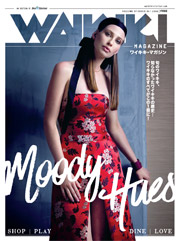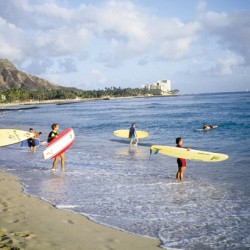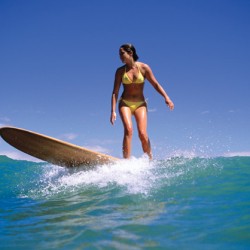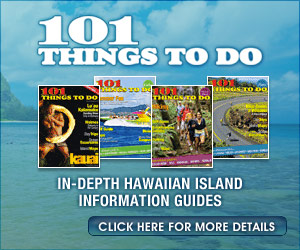SURFING: Hawai‘i’s Gift to the Sporting World
There’s no escaping the culture of surfing here on O‘ahu—it’s a part of the fabric of the island. And although you might think the bright-colored board shorts, dozens of surfboard shapes and endless surf-inspired apparel are “what it’s all about,” the essence of surfing isn’t merely an image on a T-shirt.
Early Hawaiians considered “wave sliding” a ritual and social activity, reserved for the royal family. Boards were carved from fallen trees, and rode by ali‘i (chiefs) in places that commoners weren’t even allowed in the water (Waikiki, for example). In fact, a commoner who disobeying could be sentenced to death!
- PHOTO: HAWAII TOURISM AUTHORITY (HTA)/JOE SOLEM
- Hans Hedemann (808) 924-7778 Pro Surf School Hawaii (808) 343-9667 Waikiki Beach Activities 888-904-4088
Today, there’s no less passion in the sport. The surf industry— aside from merchandising—is a multi-million dollar industry for professional surfers who earn their keep by carving turns on challenging waves. And there’s no better place to reside year round than on O‘ahu, which has the most consistent surf breaks than anywhere else in the world. With names like Baby Queens, Old Mans, Cliffs, Ka‘ena Point and Pipeline, literally hundreds of breaks can be found on our shoreline.
Yet you don’t need to be a pro to catch a wave. Most surf schools guarantee “stand up on your first lesson,” while others offer services like in-water photography or even video services (in case you need proof of your accomplishments to bring back home to your friends and family). All aim to share the “stoke” of what it feels like to catch a wave, and have it propel you through Waikiki’s tranquil, azure waters.
Generally, longboards (8 to 12 feet) are easier for beginners and ideal for paddling in the breaks around Waikiki; shortboards (under 7 feet) are meant for higher performance, quick turns and larger waves; stand-up paddleboards are a graceful, more aerobic workout that makes use of a tall paddle used to propel surfers across longer distances. All are available for rent in Waikiki, both on the beach, in surf shops and at the major resort hotels.
Whether you’re 4 or 94, there’s a wave out there for you. If you’ve never surfed, please seek out an experienced guide. However easy-seeming the surf, it’s fairly easy to get hurt in the ocean. Experienced guides will begin with a land lesson that covers the basics (and safety), followed by a “session” in the water. They range from $65/hr. up to a few hundred dollars for individual, private lessons. Below are a few names to get you started. Hang ten!
Queen Lili‘uokalani had a beach house and pier at what is now referred to as “Queens Beach” in Waikiki. Duke Kahanamoku made surfing here famous, spending the sunlit days “owning” the break that churned just 75 yards from shore, all of which paved the way for it to become one of the world’s most famous beaches and surf spots of all time.
(A statue of proclaiming him “Father of International Surfing, Duke Kahanamoku” resides overlooking the break, and is often draped in lei.)
A gentle, perfect curling, right-hand (moving right, facing shore) wave, Queens is great for beginners, yet a draw to experience local surfers who flock to it’s perfection. The inside (closest to shore) section can be teeming with for keiki, usually learning the ropes of surfing.











